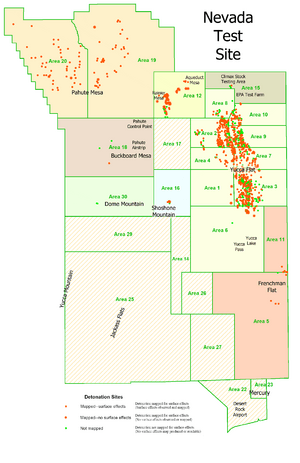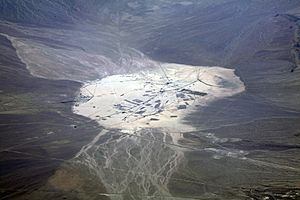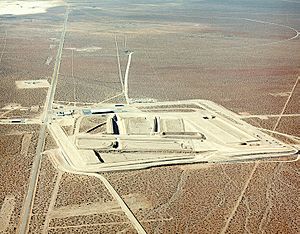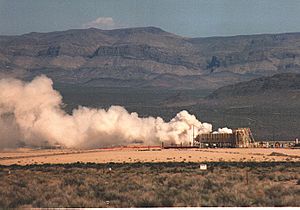Frenchman Flat facts for kids
Frenchman Flat is a large, flat area in Nevada, USA. It's part of the Nevada National Security Site. This area was once a dry lake bed, called Frenchman Lake. It covers about 15 square kilometers (6 square miles). In the 1950s, it became a very important place for the United States. It was used for testing nuclear weapons.
Before it was a test site, the dry lake bed was used as an airstrip. After the Korean War began, it was chosen for nuclear tests. Land from Nellis Air Force Base was given to the Atomic Energy Commission. They built a support site called Site Mercury there.
The first nuclear test in the continental US after 1945 happened here. It was called the "Able" test in 1951. Frenchman Flat also saw the only time a nuclear weapon was fired from a cannon. This happened in 1953 during the "Grable" test.
Contents
Area 5: A Key Test Site
Area 5 is a part of Frenchman Flat. It covers about 95 square miles (246 square kilometers). This area is north of the town of Mercury, Nevada. It includes special sites for managing waste and testing spills.
Between 1951 and 1962, 14 nuclear tests were done above ground at Frenchman Flat. Some of these tests checked how weapons affected buildings. For example, a test in 1951 caused windows to break in Las Vegas.
You can still see remains of buildings used for these tests. These remains are important for history. Five underground nuclear tests also happened here between 1965 and 1968. Fewer underground tests were done here because of the type of rock and water underground.
Managing Waste Safely
The Area 5 Radioactive Waste Management Site is a large desert area. It covers about 732 acres (296 hectares). This site is used to safely dispose of low-level radioactive waste. It also stores other types of hazardous waste.
Testing Hazardous Materials
The Nonproliferation Test and Evaluation Complex (NPTEC) is also in Area 5. It used to be called the Hazardous Material (HAZMAT) Spill Center. This is the world's largest place for testing hazardous materials outdoors. It also tests biological simulants, which are safe materials that act like dangerous ones.
The facility has a control building with computers and instruments. It also has a test area with tanks, a wind tunnel, and storage for chemicals. This center helps with large and small tests. It also provides training for handling dangerous materials.
Area 11: Another Test Zone
Area 11 covers about 26 square miles (67 square kilometers). It's on the eastern side of the Nevada National Security Site. Four tests were done here in 1954 and 1956. These tests involved spreading plutonium to study safety.
Today, the leftover materials from these tests are still there. They provide a real environment for safety training. People learn about radiation monitoring, how to take samples, and how to respond to emergencies. Five underground nuclear tests also happened in Area 11 from 1966 to 1971.
See also





